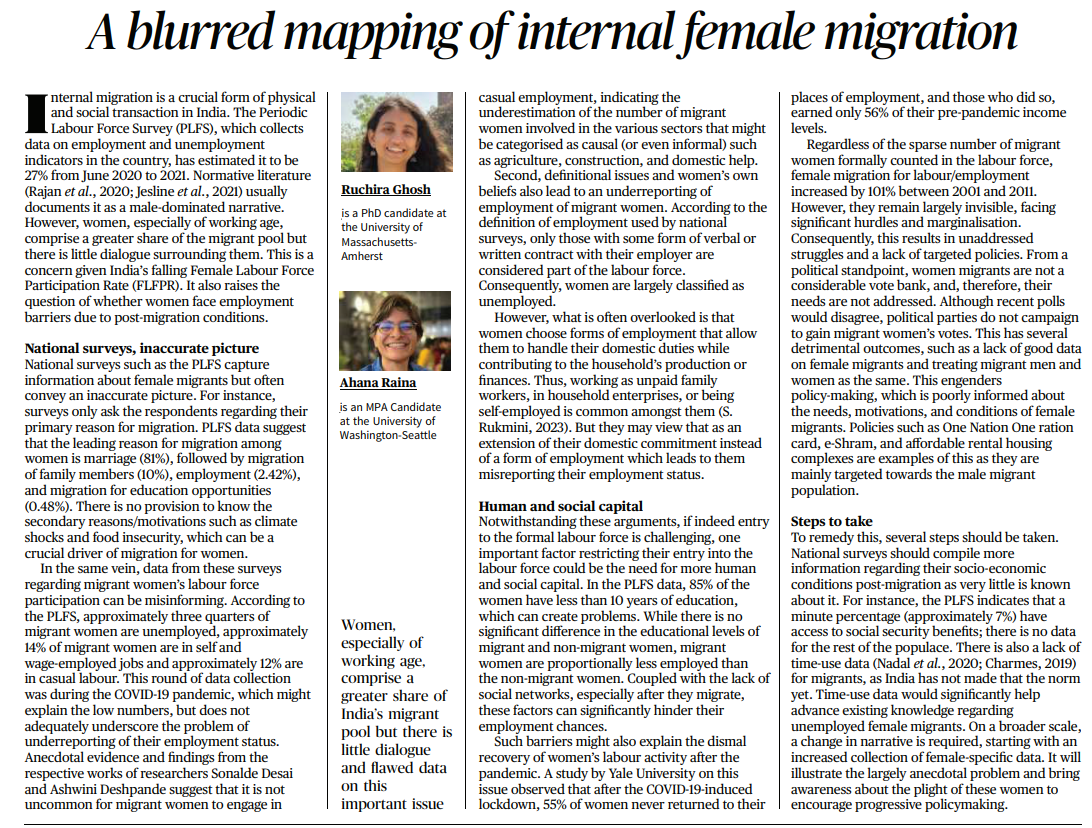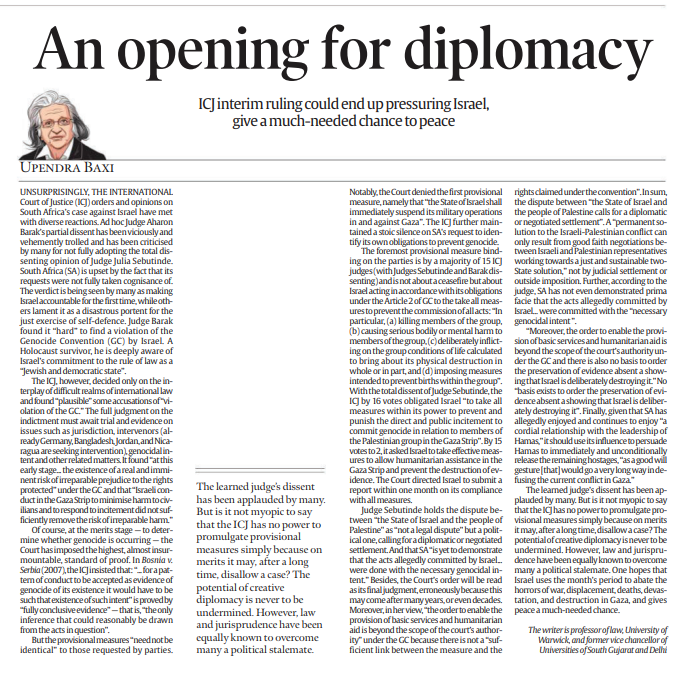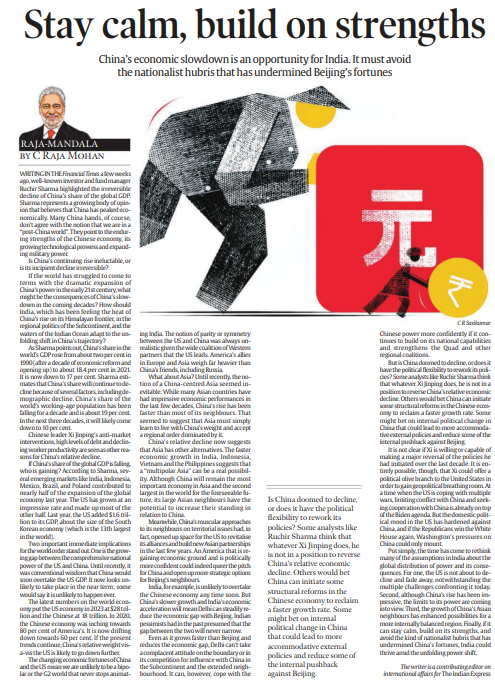The Invisible Labor Force: Unveiling the Challenges Faced by Female Migrants in India
Introduction:
- Internal migration in India, as indicated by the Periodic Labour Force Survey (PLFS), plays a crucial role in shaping the physical and social dynamics of the country.
- While normative literature often portrays migration as a male-dominated narrative, there is a significant but overlooked presence of working-age women in the migrant pool.
- This raises concerns, particularly amid the declining Female Labour Force Participation Rate (FLFPR), prompting questions about employment barriers faced by women due to post-migration conditions.
National Surveys: Inaccurate Picture:
- National surveys, such as the PLFS, present an inaccurate picture of female migration by focusing on primary reasons like marriage.
- The data overlooks secondary motivations like climate shocks and food insecurity, which can be crucial drivers for women.
- Employment statistics from these surveys may misinform, with a large proportion of migrant women classified as unemployed, possibly due to underreporting and definitional issues.
Definitional Challenges and Underreporting:
- Definitional issues, coupled with women’s beliefs about their roles, contribute to the underreporting of employment among migrant women.
- The surveys often fail to capture informal or self-employed work, which many women engage in to balance domestic responsibilities with financial contributions to the household.
Human and Social Capital:
- Entry into the formal labor force may be challenging for migrant women, with 85% having less than 10 years of education.
- Lack of social networks post-migration further hinders employment chances.
- These factors potentially explain the slow recovery of women’s labor activity post-COVID-19, with a significant percentage never returning to their places of employment.
Political Neglect and Policy Gaps:
- Despite a 101% increase in female migration for employment between 2001 and 2011, migrant women remain largely invisible in policy considerations.
- Political parties often overlook them as a significant vote bank, leading to a lack of targeted policies.
- This neglect results in poorly informed policy-making, treating migrant men and women alike and contributing to the marginalization of female migrants.
Steps to Address the Issue:
- To address these challenges, it is crucial to enhance national surveys to capture more comprehensive socio-economic conditions post-migration.
- Additionally, there is a need for a change in narrative, with increased collection of female-specific data to highlight the struggles faced by migrant women.
Access to social security benefits and time-use data for migrants can provide valuable insights into the conditions of unemployed female migrants, paving the way for informed and progressive policymaking.
ICJ Verdict on South Africa's Case Against Israel
Background and Diverse Reactions
- The International Court of Justice (ICJ) issued orders and opinions on South Africa’s case against Israel, sparking varied reactions.
- Ad hoc Judge Aharon Barak’s partial dissent has faced intense criticism for not fully aligning with Judge Julia Sebutinde’s total dissent.
- South Africa expresses dissatisfaction with its requests not being entirely acknowledged.
Israel’s Accountability and Concerns
- The verdict is seen by some as holding Israel accountable for the first time, while others view it as a potential threat to the just exercise of self-defense.
- Judge Barak, a Holocaust survivor, struggled to find a violation of the Genocide Convention by Israel, emphasizing Israel’s commitment to the rule of law as a “Jewish and democratic state.”
ICJ’s Decision and Pending Issues
- The ICJ focused on the complex realm of international law and deemed some accusations of Genocide Convention violation as “plausible.”
- The full judgment awaits trials, including jurisdiction, intervenors, genocidal intent, and related matters.
- The court identified a real and imminent risk of irreparable harm to protected rights under the Genocide Convention.
Provisional Measures and Dissenting Opinions
- The ICJ imposed a high standard of proof for determining genocide, referencing the Bosnia v. Serbia case.
- Notably, the court denied the immediate suspension of Israel’s military operations in Gaza but required Israel to act in accordance with its obligations under the Genocide Convention.
Judge Sebutinde’s Dissent and Call for Diplomacy
- Judge Sebutinde considered the dispute political, advocating for diplomatic or negotiated settlements between Israel and Palestine.
- She questioned SA’s demonstration of genocidal intent and deemed the order for basic services and humanitarian aid beyond the court’s authority.
Final Judgment Misconception and Diplomatic Potential
- The order is mistakenly perceived as the final judgment, but the resolution may take years.
- Despite applause for Judge Sebutinde’s dissent, the potential of creative diplomacy should not be underestimated.
- Law and jurisprudence can overcome political stalemates, urging Israel to use the period to alleviate the conflict’s horrors and pursue peace.
Concluding Call for Diplomacy
The dispute calls for a diplomatic solution, emphasizing good-faith negotiations for a two-State resolution. Judge Sebutinde’s dissent is acknowledged, but the note stresses the potential of diplomacy and hopes Israel seizes the opportunity to bring peace to Gaza.
China's Economic Trajectory: Assessing its Global Impact and Implications for India
Introduction:
- The Financial Times recently featured an article by investor Ruchir Sharma, asserting the irreversible decline of China’s share in the global GDP.
- This viewpoint challenges the prevailing belief in China’s unstoppable rise, leading to debates on the consequences for the world order, particularly in relation to the United States, Asia, and India.
China’s Economic Shift:
- Sharma argues that China’s share of the global GDP, which peaked at 18.4% in 2021, is now declining to around 17%, citing factors like demographic decline, anti-market interventions, high debt levels, and decreasing worker productivity.
- The slowing growth prompts questions about the ability of China, under Xi Jinping’s leadership, to reverse this trend through structural reforms or political flexibility.
Global Economic Realignment:
- Emerging markets like India, Indonesia, Mexico, Brazil, and Poland, along with the U.S., are identified as key contributors to the global economic expansion.
- The U.S., in particular, is experiencing robust growth, creating a growing gap between its comprehensive national power and China’s.
Impact on World Order:
- U.S.-China Dynamics: Contrary to earlier expectations, the U.S. continues to maintain a substantial lead in GDP over China. The evolving economic fortunes suggest a departure from the anticipated bipolar or G2 world, given the strong coalition of Western partners backing the U.S.
- Asian Dynamics: The concept of a China-centric Asia is challenged as China’s relative decline opens possibilities for a “multipolar Asia.” Rapid economic growth in India, Indonesia, Vietnam, and the Philippines indicates potential shifts in regional influence.
Implications for India:
- While India is unlikely to surpass China economically soon, its faster growth and China’s deceleration offer the prospect of narrowing the economic gap.
- India must remain vigilant in territorial and geopolitical competitions with China in the Subcontinent and the extended neighborhood.
- Strengthening alliances, such as the Quad, becomes crucial for India’s strategic positioning.
The Future of China:
- The question arises: Is China’s decline inevitable, or can it institute reforms to revive its growth? Analysts like Sharma doubt Xi Jinping’s ability to reverse economic decline, while others speculate on potential structural reforms or political changes.
- The editorial suggests that a political olive branch to the U.S. might offer China geopolitical breathing room but acknowledges the challenges given the current U.S. political mood.
Conclusion:
The narrative challenges prevailing assumptions in India about global power distribution. It highlights the enduring strength of the U.S., the limitations of China’s power, the rise of Asian neighbors, and the potential for India to thrive amid these changes through strategic planning and regional cooperation.
The evolving dynamics prompt a need for India to reassess its global position and respond proactively to the shifting geopolitical landscape.




